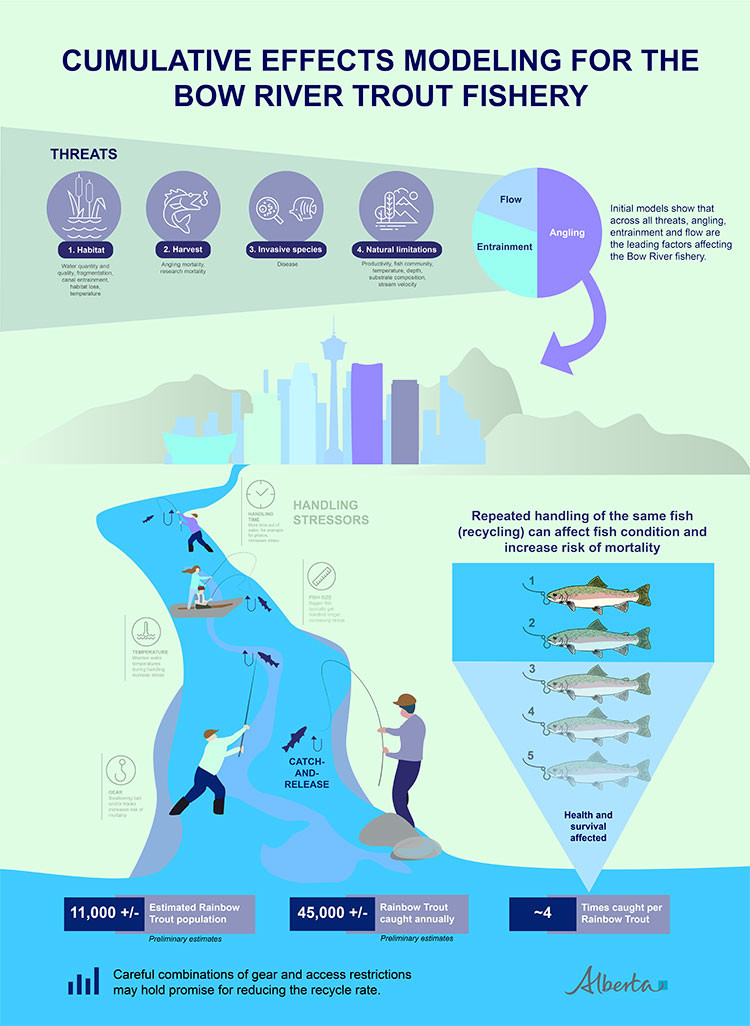Government mail service may be affected by the Canada Post labour disruption. Learn about how critical government mail will be handled.
Alberta Environment and Parks’ Fisheries biologist Dr. Michael Sullivan has hunted, fished, hiked and skied throughout Alberta’s mountains. He has a deep respect for nature and our place in it, and has taught this to his family.

His daughter, Sierra, especially followed her father’s ski trails and has been working on Athabasca Rainbow Trout genetics and recovery. Together, they have spent years traveling Alberta’s backcountry between Banff, Jasper and the Willmore Wilderness Park, gaining a real sense of perspective on Alberta’s alpine and eastern slopes fish populations.
“One of the things you can’t help but notice is the abundance of fish in the backcountry in some amazing untouched landscapes,” Michael shares. “Stories you hear from a long time ago about big and abundant fish still seem to be true in the backcountry.”
This is a stark contrast to many of today’s foothills streams in Alberta, including the Bow River.
The Bow River fishery matters
Rainbow Trout and Brown Trout were first introduced into the Bow River through stocking between the 1920s and late 1940s. Originating from the picturesque Bow Lake in Banff National Park and fed by glacial meltwater from the Bow Glacier, the Bow River makes its way through the Rocky Mountains and foothills of southwestern Alberta before passing skyscrapers in Calgary’s downtown and on into the prairies.
It’s this stretch downstream from Calgary that made the Bow world-renowned among thousands of anglers from across Alberta, Canada and beyond for its blue ribbon sport fishing opportunity on these 2 species of trout. The Bow River also acts as a lifeline for southern Alberta, supporting diverse aquatic and riparian communities within the arid prairie landscape and providing drinking water, irrigation and power for millions of municipal, industrial and agricultural users.
Rainbow and Brown Trout have naturalized in the Bow, reproducing and forming sustainable populations that support one of the highest effort fisheries in the entire province and injecting an estimated $24.5 million into the local economy each year. However, a recent decline in the Rainbow Trout population – documented by Michael’s colleagues from Alberta Environment and Parks (AEP) and collaborators from the University of Calgary – presents a major concern to the public, anglers and fisheries managers alike.
Interestingly, the decline doesn’t affect all Rainbows equally.
“We learned 2 things from over 20 years of fish population data: young fish are consistently abundant in the Bow, but we have experienced rapid and high losses of older fish,” Michael explains. “As a rule of thumb, we generally see declines in young fish with habitat or disease issues. Big fish loss is almost always a harvest or entrainment (i.e., the loss of fish whenever streams, creeks or rivers are diverted for irrigation and other uses) issue.”

Joe Modelling to fill knowledge gaps
Numerous stressors can affect the Bow fishery individually or collectively, including major flood events, whirling disease, water flows, habitat loss and high angling pressure. This complexity makes it difficult to identify which factors might be responsible for the recent decline.
To better understand cumulative stressors, AEP created the Bow River Cumulative Effects Modelling Group in collaboration with stakeholders in 2020. The team is using a modelling technique called ‘Joe Modelling’ – named after late Dr. Joe Nelson in honour of his exceptional contributions to Alberta fisheries knowledge – and backed with a science review in the Canadian Science Secretariat Publication in 2018.
A Joe Model quantifies the impact of each stressor in terms of magnitude and severity, identifying potential factors affecting a specific fishery, and allowing biologists to compare stressors and assess outcomes from proposed mitigation actions. With input from public meetings, data from field studies and extensive literature reviews, biologists can develop a Joe Model.
“Typically, our models will have 15 to 20 different stressor-response curves,” Michael explains, adding that the Bow River model helps biologists identify which stressors likely matter, and which ones can be ruled out. “Instead of looking at 20 threats, we can say that a handful of factors really matter and need action.”
The 3 stressors of importance (at this early stage of modelling) for the Bow River fishery appear to be angling, entrainment and flow. Michael points out that angling is just one sub-model in a model of 20 potential stressors – it is perhaps 50% of the problem, but not the whole picture. “Our model is just a hypothesis, but the data we’re seeing on the Bow River seems to show that we’ve got an issue.”
Michael also describes 2 critical limitations of any cumulative effects problem “The first problem is the blame game – each group (anglers for example) say fix the other issue before you restrict me!” Michael reports. The second problem is what he calls the uncertainty cloud: “Big restrictions have a much smaller effect. So, if 50% of the problem is overfishing and we reduce angling by 50%, that’s actually only a 25% effect on the whole problem. You might not see an improvement that, at first glance, seems equal to the management response, even if it’s having a positive impact.”
There are huge social and economic costs to restrictions, and as Michael observes, “It’s hard to push these levers when you can’t prove that the lever you pushed matters.”
Michael also points out that these are human dimensions issues, not science issues. “More or better science is not going to solve the problem in this situation.”
Few fish – lots of fishing
Recreational fisheries such as the Bow River fishery can decline and collapse even under catch-and-release-only regulations where anglers must release all fish they catch. Despite catch-and-release-only regulations being formally implemented on the Bow River in 2017, data from the angler use surveys on the Bow River in 2006 showed virtually no fish were reported as being harvested. But how can angling contribute to a fish decline when no fish are harvested? It depends in part on how many people are out fishing.
To answer specific questions on angling effort including how many anglers there are and where and when they fish, AEP and Alberta Conservation Association staff surveyed the Bow River between June and September 2018. It’s the second time they completed an Angler Use Survey for the Bow, allowing the biologists to compare data with their first such survey in 2006.
Overall angler effort was 15% higher in 2018, correlating with the population growth in and around Calgary. Subsequent information indicates the COVID-19 pandemic saw record level fishing licence sales, pointing to even higher angling pressure. The survey data also shows that 90% of the angling pressure is concentrated during summer (75%) and autumn (15%).
In 2018, anglers spent an estimated 200,000 hours on the Bow (2018 Survey to Estimate Angler Effort on the Bow River). For the study reach of Fish Creek to Carseland, biologists estimated that approximately 45,000 trout were reported caught in the summer season of 2018. The same year, initial analysis of mark-recapture tagging data suggests that reach may only have held about 11,000 catchable-sized trout.
“On average, each fish was reported to have been caught perhaps 4 times in 2018 alone,” Michael reports. “If you look at the face of a Bow River Rainbow, typically you will see hook scars or damaged upper mandibles – you can see direct evidence that the fish are being caught multiple times.”
Biologists refer to the repeated catching of the same fish as recycle rate. If there are 10 fish in the river and we catch 50 fish, we’ve recycled each fish 5 times on average. Fish have to live through multiple years of being caught numerous times each summer to become old and big. Often people focus solely on the hooking mortality rate (i.e., the probability of mortality after being caught and released once); however, it is the accumulation of these individual events that affects populations.
A sufficiently high recycle rate, coupled with any hooking mortality rate, can lead to increased fish mortality and a subsequent decline in the fishery – unless there are interventions.
Bringing back the Rainbows
In the late 1980s before the Bow fishery became famous, the recycle rate was probably near or less than one – a rate which Michael estimated kept the fishery at a high quality level for anglers.
“If the recycle rate is over 2, we likely see a decline and very few big fish, while getting it near one will probably lead to more and bigger fish. We have a lot of work ahead of us to get the recycle rate down from the current estimate of 4.”
Numerous ideas have been discussed to reduce the Rainbow Trout recycle rate, including temporarily closing the fishery or periodically closing it during the summer and autumn. “While potentially effective and fast-acting, these are draconian measures with terrible consequences for fishing and the economy,” Michael cautions.
The alternative? Some modelled scenarios suggest careful combinations of fishing gear and access restrictions may hold great promise for getting the recycle rate closer to one. While this approach would mean a slower recovery time, it might still allow the Bow River Rainbow population to recover while providing anglers the opportunity to remain on the river.
“Some of the gear – while not wrong or unethical – might just be too effective for the current fishery,” Michael elaborates. “We might need a period where we are less effective in catching Rainbows to get the recycle rate down for conservation and to meet our current management objective of a true blue ribbon, old growth fishery.”
Handling techniques also matter. Michael adds that holding a fish out of the water for more than 30 seconds, especially on hot days, can lead to increased mortality.
Next steps for the Bow River team include running models to determine the best path forward, and working with stakeholders, local experts and citizen scientists to put test regulations in place and monitor population effects.
“If we wait for more evidence – and more decline – it means a situation even worse for the Rainbows and potentially harsher and longer restrictions for anglers,” Michael explains.
Domino effects on fishing pressure

Because the Bow River is not just one of Alberta’s most popular fisheries, but also a very important fishery environmentally, socially and economically, it will continue to receive sustained research attention in the coming years. Similar data are available for Brown Trout in the Bow River, another fish prized by anglers but whose abundance is lower than Rainbows. Data on Brown Trout are currently being analyzed and we await what the information may tell us.
“With 60,000 anglers, the Bow River is a huge domino that – if it collapses – would have far-reaching effects on other, smaller river systems,” Michael explains.
He points out that a collapse of the Bow River fishery could send 60,000 anglers to the Crow, Oldman, Highwood, Ram, Cardinal, and farther north into the Athabasca river systems – systems that are much less resilient than the Bow and contain listed Species at Risk. And those systems could consequently be degraded or potentially fail.
Michael’s conclusion: “We can’t let the Bow fail. It is part of Alberta’s heritage.”
Additional resources
- Fact sheet: Bow River Fisheries Management
- Technical report: Survey to Estimate Angler Effort on the Bow River near Calgary during June to September 2018 (Christensen et al. 2020)
- Peer-reviewed research document: Alberta’s Fisheries Sustainability Assessment: A Guide to Assessing Population Status, and Quantifying Cumulative Effects using the Joe Modelling Technique (MacPherson et al. 2019)
- Peer-reviewed article: Detailed population analysis of rainbow trout from 2003-2013 (Cahill et al. 2018)
- YouTube video: Bow River Fisheries Education Session about the current status of the fishery in the Bow River
-

Dr. Jonathan Thompson
Dr. Jonathan Thompson was appointed as Environment and Protected Areas’ Chief Scientist on October 13, 2020.

